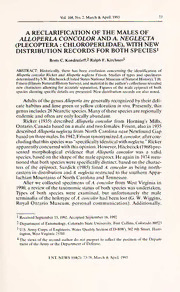
A Reclarification Of The Males Of Alloperla concolor And A-Neglecta Species PDF
Preview A Reclarification Of The Males Of Alloperla concolor And A-Neglecta Species
Vol. 104,No. 2,March &April, 1993 73 A RECLARIFICATION OF THE MALES OF ALLOPERLA CONCOLOR AND A. NEGLECTA (PLECOPTERA CHLOROPERLIDAE), WITH NEW DISTRIBUTION: RECORDS FOR BOTH SPECIES1 BorisC. Kondratieff,2 Ralph F. Kirchner3 ABSTRACT: Historically, there has been confusion concerning the identification of Alloperla concolor Ricker and Alloperla neglecta Prison. Studies oftypes and specimens determinedbyS.W.Hitchcock(UnitedStatesNationalMuseumofNaturalHistory),T.H. Prison(IllinoisNaturalHistorySurvey),andmaterialintheauthor'scollectionsrevealed new characters allowing for accurate separation. Figures ofthe male epiproct ofboth speciesshowingspecificdetailsarepresented. Newdistribution recordsarealso noted. Adults ofthe genusAlloperla are generally recognized by theirdeli- cate habitus and lime green oryellowcoloration in vivo. Presently, this genus includes28Nearcticspecies. Manyofthesespeciesareregionally endemic and often are only locally abundant. Ricker (1935) described Alloperla concolor from Homing's Mills, Ontario,Canada based on a maleand two females. Prison, also in 1935 describedAlloperla neglecta from North Carolina nearNewfound Gap basedonthreemales.In 1942,PrisonsynonymizedA.concolor, aftercon- cludingthatthisspecieswas"specificallyidenticalwithneglecta."Ricker apparentlyconcurredwiththisopinion.However,Hitchcock(1968)pre- sented morphological evidence that Alloperla concolor was a valid species,basedontheshapeofthe maleepiproct. Heagain in 1974men- tioned that both species were specificallydistinct, based on the charac- ters of the epiproct, Surdick (1985) listed A. concolor as being north- eastern in distribution andA. neglecta restricted to the southern Appa- lachian Mountains ofNorth Carolina and Tennessee. After we collected specimens ofA. concolor from West Virginia in 1990, a reviewofthe taxonomic status ofboth species was undertaken. Types of both species were examined, but unfortunately the male terminalia ofthe holotype ofA. concolor had been lost (G. W. Wiggins, Royal Ontario Museum, personal communication). Additionally, 1 Received September 15, 1992.Accepted September 16. 1992 2 Department ofEntomology, Colorado State University, Fort Collins, Colorado 80523 3 U.S. ArmyCorpsofEngineers,WaterQualitySection (ED-HW), 502 8th Street. Hunt- ington.WestVirginia 25701 4The views ofthe second author do not purport to reflect the position ofthe Depart- mentoftheArmyorthe DepartmentofDefense. ENT. NEWS 104(2): 73-78. March & April. 1993 ENTOMOLOGICALNEWS 74 material determined byHitchcock(United States National Museumof Natural History) and Prison (Illinois Natural History Survey) were also examined. RESULTS AND CONCLUSIONS Figs. 1-6illustratetheapexoftheepiproctofbothspecies.Contraryto Hitchcock's (1968) observations that the epiproct ofA. neglecta lacked distalserration,bothspecieshavetheseserrations(Fig. 1).Inlateralview the epiproct ofA. concolor resembles the head ofa duck, flattened and forming a distinct serrated edge at the top (Figs. 2A, 3), whereas A. neglecta has subparallel margins with the tip rounded (Figs. 2B, 5). In dorsalaspecttheepiproctofA.concolorisnearlyaswideaslong,butinA. neglecta the epiproct is two times as long as wide (Figs. IB, 5, 6). Speci- mens collected from southwestern Virginia, which were thought to be Alloperla concolor by Kondratieff and Kirchner (1987), are A. neglecta. This represents a northern range extension. The records ofA. concolor from West Virginia represent a new state record and a southern range extension for this species. Map 1 indicates the recorded distribution of both species, including the records listed below. A 1 B 1 Fig. I.Apex ofepiproct,dorsal view. A.A. concolor: B..A. neglecta. Vol. 104,No. 2,March &April, 1993 75 B Fig.2.Epiproct,lateralview.A.,A.concolor;B.,A.neglecta. (MB1haa3o-trlVeko1rht-iya1pam9els6)4t,E,exaS2adWm,fipH1ni-ienVtdInc-e:hd1cA9.ol6c7lCk,oo,pSne3rnWlemac,Htci8oitncfcc.uohWtlceo:orsc:tkHO,aVnri4ttrlamgarinin3doi,,af.:C1NaN4ein-cwaVhdMoHa9la:6am6sHp,CosomhS.ii,WnrngeeH':aisrtNcMRoihirlcctloshhc,wkWo,1oomod1d.psmNit,onornc1tekhd,f. ForkCherryRiver,14-V-1990,B.C.KondratiefT,J.L.Welch&R.F.Kirchner,2m.1 f;same but2-V1-1992, 1 m. 1934A,llTopHerPlraisneognl,ec1tam:(NpoarrtarhypCea)r;oHlianyaw:oSowdaCion.,CoS.h,in(nienagr)RoNcekwfNaotuln.dReGca.pA.re3a5,60Eafst,t2F8o-rVk- LittlePigeonRiver, 17-V-1983,BCKondratieff&RFKirchner, 18m;samebut23-V-1990, BC Kondratieff, RFKirchner&JLWelch,7 m,6f.Tennessee: SevierCo.,(West Prong) LittlePigeonRiver,(near)NewfoundGap, 14-V-1939,THPrison&HH Ross,4m;Sevier Co.,Gatlinburg, 14-VI-1940,TH Prisonetal. 1 m5f.Virginia:GraysonCo.,LewisFork. 2-VII-1978, RF Kirchner & GT Voreh, 4 m; same but 18-V-1990, BC Kondratieff. RF Kirchner&JLWelch,58 m,35 f. 76 ENTOMOLOGICALNEWS *.& Figs.3-6.Epiproct,/!concolor;3.Lateral(680X),4.apex,dorsalview(81OX).A.neglecta;5. lateral(600X),6. apex,dorsal view(925X). Vol. 104,No.2,March&April, 1993 77 Map 1. Distributionof/I. concolor(),A. neglecta(). ACKNOWLEDGMENTS We thank Oliver S. Flint, Jr. (United States Museum ofNatural History), Glenn B. Wiggins (Royal Ontario Museum), and Kathryn C. McGiffen (Illinois Natural History Survey)forprovidingcriticalmaterialforstudy.Additionally,weappreciatethecomments on this project by the participants ofthe XI International Symposium on Plecoptera (August 17-20),Tomahawk,Wisconsin. 78 ENTOMOLOGICALNEWS LITERATURECITED Prison, T. H. 1935. New North American species ofthe genus Alloperla (Plecoptera: Chloroperlidae).Trans.Amer. Entomol. Soc.61: 331-344. Prison,T. H. 1942. Studies ofNorthAmerican Plecoptera with special referencetothe faunaofIllinois. Bull. IllinoisNat.Hist. Sur.22: 235-355. Hitchcock,S.W.\968.Alloperla(Chloroperlidae:Plecoptera)oftheNortheastwithakey tospecies.J.NewYorkEntomol. Soc.76: 39-46. Hitchcock,S.W. 1974.GuidetotheInsectsofConnecticut.PartVII.ThePlecopteraor stonefliesofConnecticut.StateGeologicalandNaturalHistorySurveyofConnecticut, DepartmentofEnvironmental Protection. Bull. 107.262pp. Kondratieff, B. C. and R. P. Kirchner. 1987. Additions, taxonomic corrections, and faunal affinitiesofthe stoneflies(Plecoptera)ofVirginia, USA. Proc. Entomol. Soc. Wash. 89: 24-30. Ricker,W.E. 1935.NewCanadianperlids(PartII).Can. Entomol.67: 256-264. Surdick, R. P. 1985. Nearctic genera ofChloroperlinae (Plecoptera: Choroperlidae). IllinoisBiol. Monogr. 54: 146pp. BOOKS RECEIVED AND BRIEFLYNOTED CATERPILLARS. ECOLOGICAL AND EVOLUTIONARY CONSTRAINTS ON FORAGING. N.E. Stamp andT.M. Casey,eds. 1993. Chapman &Hall. 587 pp.$75.00 Thisvolumeprovidesaframeworkforaunifiedtheoryofforaging,takingintoaccount howtwoormoreconstraintsinfluencecaterpillars. Rangingfrombehavioraland nutri- tionalecologytoinsectphysiologyandbiophysics,itwillserveasavaluableresourcefor courses in insect-plant interactions, insectecology,populationandcommunityecology, andbiologicalcontrol. INSECT LEARNING. ECOLOGICAL AND EVOLUTIONARY PERSPECTIVES. D.R. Papaj andA.C. Lewis,eds. 1993.Chapman& Hall.398pp.$54.95 This volume challenges the widespread view that insect behavior is rigidly pro- grammed and inflexible. There is increasing recognition that there is plasticity in the behaviorofinsectsthatcanbeexplainedonlybylearning.Thisbooksurveysanumberof studies on the ecology, evolution, and mechanisms oflearning in a number ofinsect species,bothsocial and non-social.
